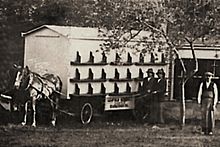Beehive


The bees cart is an apiary on wheels, the (also depending on the design up to 50 beehives booties called or hives) can be fitted.
With a beehive, it is possible to move the entire apiary to a new area in which the bees can enjoy cheaper costumes . Today the mobile beehive is pulled by a motor vehicle; in the past it was also a horse.
On bees cars usually come back treatment booties (the "norm prey 52" such. B.) used. With these, all floors of the floor are directly accessible from the rear. Thus, in the car several nations are stacked without the access is made more difficult, while in the more widely today magazine booties for editing frames to be stacked, something against their use in cars or bee -häusern talks. The beekeeper's most important equipment can also be carried and stored in the beehive.
One of the earliest records of beehives is shown in a woodcut in the book Historia de gentibus septentrionalibus by the Swedish Archbishop Olaus Magnus from 1555. Beehives were used on a large scale and systematically in the GDR . Today, these beehives are only used by enthusiasts, as the appropriate back-treatment hives are considered too small for the bee colonies that have grown significantly larger as a result of selection.